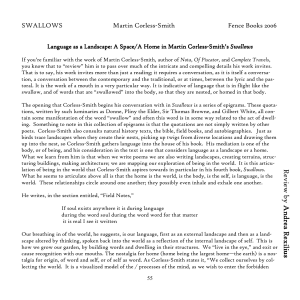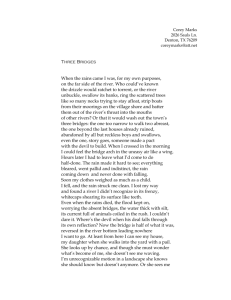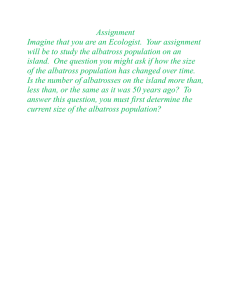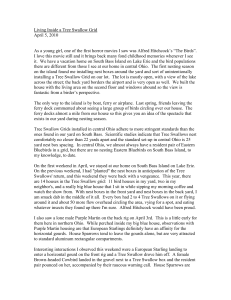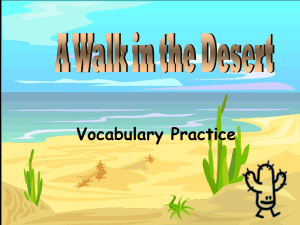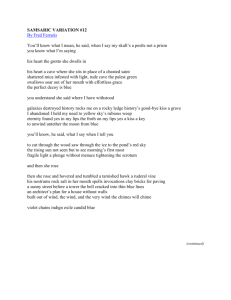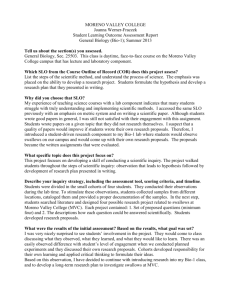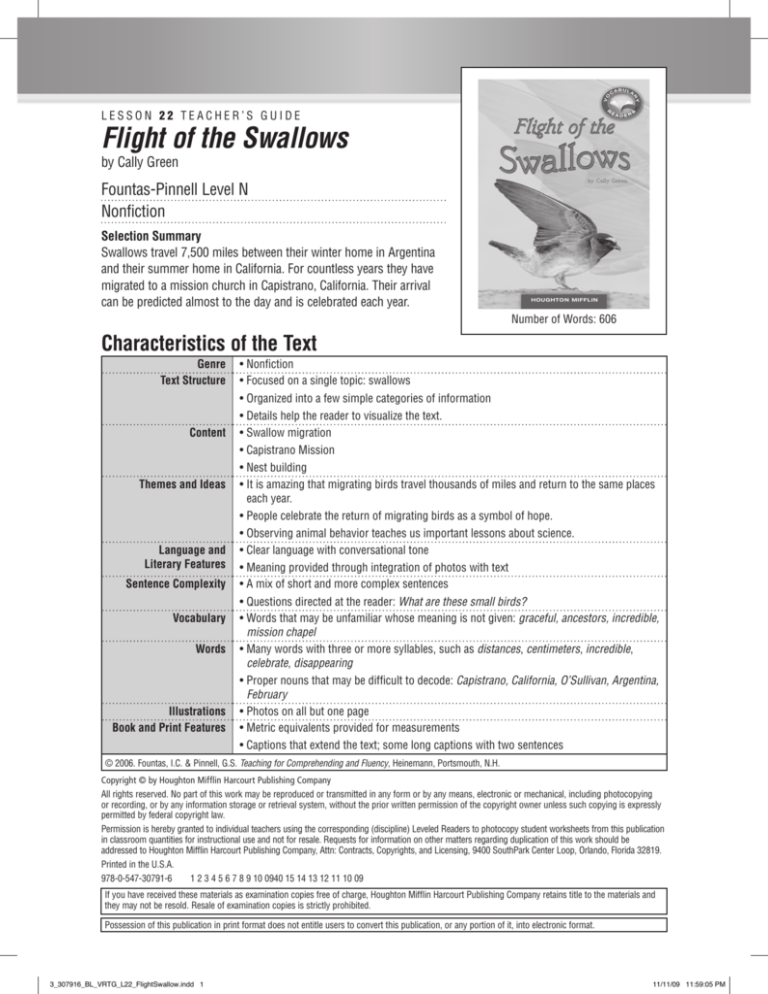
LESSON 22 TEACHER’S GUIDE
Flight of the Swallows
by Cally Green
Fountas-Pinnell Level N
Nonfiction
Selection Summary
Swallows travel 7,500 miles between their winter home in Argentina
and their summer home in California. For countless years they have
migrated to a mission church in Capistrano, California. Their arrival
can be predicted almost to the day and is celebrated each year.
Number of Words: 606
Characteristics of the Text
Genre
Text Structure
Content
Themes and Ideas
Language and
Literary Features
Sentence Complexity
Vocabulary
Words
Illustrations
Book and Print Features
• Nonfiction
• Focused on a single topic: swallows
• Organized into a few simple categories of information
• Details help the reader to visualize the text.
• Swallow migration
• Capistrano Mission
• Nest building
• It is amazing that migrating birds travel thousands of miles and return to the same places
each year.
• People celebrate the return of migrating birds as a symbol of hope.
• Observing animal behavior teaches us important lessons about science.
• Clear language with conversational tone
• Meaning provided through integration of photos with text
• A mix of short and more complex sentences
• Questions directed at the reader: What are these small birds?
• Words that may be unfamiliar whose meaning is not given: graceful, ancestors, incredible,
mission chapel
• Many words with three or more syllables, such as distances, centimeters, incredible,
celebrate, disappearing
• Proper nouns that may be difficult to decode: Capistrano, California, O’Sullivan, Argentina,
February
• Photos on all but one page
• Metric equivalents provided for measurements
• Captions that extend the text; some long captions with two sentences
© 2006. Fountas, I.C. & Pinnell, G.S. Teaching for Comprehending and Fluency, Heinemann, Portsmouth, N.H.
Copyright © by Houghton Mifflin Harcourt Publishing Company
All rights reserved. No part of this work may be reproduced or transmitted in any form or by any means, electronic or mechanical, including photocopying
or recording, or by any information storage or retrieval system, without the prior written permission of the copyright owner unless such copying is expressly
permitted by federal copyright law.
Permission is hereby granted to individual teachers using the corresponding (discipline) Leveled Readers to photocopy student worksheets from this publication
in classroom quantities for instructional use and not for resale. Requests for information on other matters regarding duplication of this work should be
addressed to Houghton Mifflin Harcourt Publishing Company, Attn: Contracts, Copyrights, and Licensing, 9400 SouthPark Center Loop, Orlando, Florida 32819.
Printed in the U.S.A.
978-0-547-30791-6
1 2 3 4 5 6 7 8 9 10 0940 15 14 13 12 11 10 09
If you have received these materials as examination copies free of charge, Houghton Mifflin Harcourt Publishing Company retains title to the materials and
they may not be resold. Resale of examination copies is strictly prohibited.
Possession of this publication in print format does not entitle users to convert this publication, or any portion of it, into electronic format.
3_307916_BL_VRTG_L22_FlightSwallow.indd 1
11/11/09 11:59:05 PM
Flight of the Swallows
by Cally Green
Build Background
Help students use their knowledge of bird migration to visualize the book. Build interest by
asking questions such as the following: What birds do you see only in certain seasons of
the year? Where do you think the birds go during other seasons? Read the title and author
and talk about the cover illustration. Explain that the bird that is pictured is a swallow, a
bird that makes a long journey twice a year between its winter and summer homes.
Introduce the Text
Guide students through the text, noting important ideas and nonfiction features. Help with
unfamiliar language so they can read the text successfully. Give special attention to target
vocabulary. Here are some suggestions:
Pages 2–3: Direct attention to the photo and the caption. Point out that captions
can give clues about information in the text.
Suggested language: Turn to page 2 of this book. The caption tells us that
hundreds of swallows migrate each year. They fly from one place to another to
live. How does the photo give you an idea of how many birds migrate at a time?
Pages 4–5: Read the heading, “Capistrano,” and tell students that this is a place
in California where swallows spend the summer. When fall comes and the weather
gets chilly, the birds leave. Capistrano isn’t comfortable for the birds when the
weather gets cold. Where do you think the birds go in chilly weather?
Page 9: Read the caption. The caption says that the church ruins were good
places for nests. This tells me that there must have been an accident at the
mission, a harmful event that caused the building to be ruined. In fact, there was
an earthquake! It was frightening for the people who lived there. Do you think the
birds found it scary, too?
Now turn back to the beginning of the book and read to find out about the amazing
flight of the swallows.
Target Vocabulary
accidents – events that happen
and may cause harm, p. 9
chilly – cold enough to make you
feel uncomfortable, p. 5
dramatic – spectacular or
suspenseful, p. 10
frightening – scary, p. 9
landscape – a long stretch of
land seen from one place, p. 5
migrate – move to a different
place at a particular time of
year, p. 2
plenty – enough or more than
enough, p. 9
solid – hard, with no breaks or
hollow parts, p. 8
survival – the act of continuing to
live, p. 10
thunderous – very loud, p. 9
Grade 3
2
Lesson 22: Flight of the Swallows
© Houghton Mifflin Harcourt Publishing Company
3_307916_BL_VRTG_L22_FlightSwallow.indd 2
7/29/09 5:30:06 PM
Read
Have students read Flight of the Swallows silently while you listen to individual students
read. Support their problem solving and fluency as needed.
Remind students to use the Visualize Strategy
details to picture what is happening.
, and to use selection
Discuss and Revisit the Text
Personal Response
Invite students to share their personal responses to the book.
Suggested language: What did you learn about swallows that you didn’t learn before?
What do you think people are doing to keep the swallows safe?
Ways of Thinking
As you discuss the text, help students understand these points:
Thinking Within the Text
Thinking Beyond the Text
Thinking About the Text
• Swallows migrate 7,500 miles
between their winter homes in
Argentina and their summer
homes in California.
• The times when some migrating
birds arrive and leave a place can
be predicted.
• The text is organized by topics.
• Swallows build mud nests.
• People in Capistrano, California,
celebrate the arrival of the
swallows each year.
• People enjoy celebrating events
such as the return of migrating
birds.
• By observing animal behavior
we can learn important lessons
about nature.
• The captions help describe what
is shown in the photos.
• The author includes many
details about swallows and their
migration.
• The writer’s attitude is that the
migration of swallows is amazing
and that people should work to
save the birds and their habitat.
© 2006. Fountas, I.C. & Pinnell, G.S. Teaching for Comprehending and Fluency, Heinemann, Portsmouth, N.H.
Choices for Further Support
• Fluency Invite students to choose a passage from the text and demonstrate phrased
fluent reading. Remind them to group words into meaningful phrases to show that
they understand what they are reading.
• Comprehension Based on your observations of the students’ reading and discussion,
revisit parts of the text to clarify or extend comprehension. Remind students to go
back to the text to support their ideas.
• Phonics/Word Work Provide practice as needed with words and word parts, using
examples from the text. Remind students that some verbs, such as fly, are irregular;
their past forms are not made by adding –ed: fly, flew, has/have flown. Have students
skim the text to find other examples of irregular verbs. Examples include spent
(spend) on page 3 and left (leave), built (build), and began (begin) on page 5.
Grade 3
3
Lesson 22: Flight of the Swallows
© Houghton Mifflin Harcourt Publishing Company
3_307916_BL_VRTG_L22_FlightSwallow.indd 3
11/11/09 11:59:25 PM
Writing about Reading
Vocabulary Practice
Have students complete the Vocabulary questions on BLM 22.1.
Responding
Have students complete the vocabulary activities on page 11. Remind them to answer the
Word Teaser on page 12. (Answer: plenty)
Reading Nonfiction
Nonfiction Features: Captions and Photos Remind students that nonfiction has many
features to help readers find and understand important information. Captions and
photos are two of these features. Explain that captions can be short phrases or longer
sentences—sometimes even two sentences, as in this book. Captions tell what a photo,
illustration, map, or diagram is about. Reading the captions in a nonfiction book is a good
way to preview the book before reading the main text.
Photos are another important source of information. They often add information that is not
in the text. Have students look again at the photos on pages 8 and 9. Ask what information
they can learn from the photos (what a swallow’s nest looks like, where swallows attach
their nests). Then have students choose a photo from the book and write a different
caption for it, based on what they see in the photo.
Writing Prompt: Thinking Beyond the Text
Have students write a response to the prompt on page 6.
Assessment Prompts
• How do the photos on pages 8 and 9 help you understand the meaning of solid as it
describes swallows’ nests?
• Which word on page 9 has almost the same meaning as loud?
• Which words on page 6 explain how swallows migrate?
Grade 3
4
Lesson 22: Flight of the Swallows
© Houghton Mifflin Harcourt Publishing Company
3_307916_BL_VRTG_L22_FlightSwallow.indd 4
11/11/09 11:59:34 PM
English Language Development
Reading Support Check regularly on students’ oral reading to determine accuracy,
fluency, and comprehension.
Vocabulary Provide assistance with challenging words that are not defined directly in
text, such as graceful (page 2), sheltered (page 3), ancestors (page 4), air currents (page
7), plaster (page 8), and celebrate (page 10).
Oral Language Development
Check student comprehension, using a dialogue that best matches your students’
English proficiency level. Speaker 1 is the teacher, Speaker 2 is the student.
Beginning/Early Intermediate
Intermediate
Early Advanced/ Advanced
Speaker 1: What do you see on the
cover?
Speaker 1: Where is the swallows’
summer home?
Speaker 1: What makes swallows
built for flying?
Speaker 2: A bird
Speaker 2: The swallows’ summer home
is in California.
Speaker 2: Swallows have long,
powerful, pointed wings and long
tails.
Speaker 1: What kind of bird is this?
Speaker 2: It is a swallow.
Speaker 1: In what country is the
swallows’ winter home?
Speaker 2: The swallows’ winter home is
in Argentina.
Speaker 1: How do swallows
make their nests?
Speaker 2: They make a paste of
soil and water to build the walls
of their nests.
Lesson 22
Name
BLACKLINE MASTER 22.1
Date
Target Vocabulary
Flight of the Swallows
Target Vocabulary
Answer each question yes or no. Then tell why.
Possible responses shown.
1. Do people migrate when they go on vacation?
no, because people aren’t moving to a new place
2. Do you need food and water for survival?
yes, because I need food and water to live
3. Does a woman with ten dogs have plenty of dogs?
yes, because ten is a lot of dogs for one person
4. Is seeing a school bus in front of a school frightening?
no, because that’s where a school bus should be
Vocabulary
migrate
survival
plenty
frightening
accidents
solid
chilly
landscape
thunderous
dramatic
5. Could you have an accident playing baseball indoors?
yes, because something would probably break
6. Is ice more solid than water?
yes, because ice is frozen water
7. Will chilly weather make cliff swallows fly south?
yes, because they need warmer weather to survive
8. Is a landscape painting a picture of a person?
no, because a landscape is land viewed as scenery
9. Would you cover your ears around a thunderous noise?
yes, because it would be as loud as thunder
10. Would you enjoy watching a dramatic rescue?
yes, because it would be very exciting
Read directions to students.
3
Target Vocabulary
Grade 3, Unit 5: Going Places
© Houghton Mifflin Harcourt Publishing Company. All rights reserved.
3_246239RTXEAN_L21-25TV.indd Sec1:3
Grade 3
5
12/7/09 11:14:27 PM
Lesson 22: Flight of the Swallows
© Houghton Mifflin Harcourt Publishing Company
First Pass
3_307916_BL_VRTG_L22_FlightSwallow.indd 5
1/12/10 4:07:35 PM
Name
Date
Flight of the Swallows
Thinking Beyond the Text
Think about the questions below. Then write your answer in one or two
paragraphs.
Imagine that you live in Argentina. It is February. You notice that the
swallows are getting ready to fly north and you wonder where they go, and
why they leave. Write a diary entry from the point of view of a child in
Argentina, saying goodbye to the swallows.
Grade 3
6
Lesson 22: Flight of the Swallows
© Houghton Mifflin Harcourt Publishing Company
3_307916_BL_VRTG_L22_FlightSwallow.indd 6
7/29/09 5:30:09 PM
Lesson 22
Name
BLACKLINE MASTER 22.1
Date
Target Vocabulary
Flight of the Swallows
Target Vocabulary
Answer each question yes or no. Then tell why.
Vocabulary
1. Do people migrate when they go on vacation?
2. Do you need food and water for survival?
3. Does a woman with ten dogs have plenty of dogs?
4. Is seeing a school bus in front of a school frightening?
migrate
survival
plenty
frightening
accidents
solid
chilly
landscape
thunderous
dramatic
5. Could you have an accident playing baseball indoors?
6. Is ice more solid than water?
7. Will chilly weather make cliff swallows fly south?
8. Is a landscape painting a picture of a person?
9. Would you cover your ears around a thunderous noise?
10. Would you enjoy watching a dramatic rescue?
Grade 3
7
Lesson 22: Flight of the Swallows
© Houghton Mifflin Harcourt Publishing Company
3_307916_BL_VRTG_L22_FlightSwallow.indd 7
1/12/10 4:08:50 PM
Student
Lesson 22
Date
BLACKLINE MASTER 22.23
Flight of the Swallows • LEVEL N
page
Selection Text
2
Flight of the Swallows
Running Record Form
Errors
Self-Corrections
Accuracy Rate
Total SelfCorrections
It happens every spring. Thousands of small, graceful
birds fill the sky, moving through the air with a purpose. They
have all flown a long distance toward a place they know. They
have important work to do.
3
After a summer spent in the sheltered walls of an old
church, they will leave to start another long trip. They will fly
back to where they started in the spring.
What are these small birds? Where are they going?
These are swallows, on their way to or from their
California home.
The little birds fly the same route every year to a famous
4
church in Capistrano, California.
Comments:
(# words read
correctly/105 ×
100)
%
Read word correctly
Code
✓
cat
Repeated word,
sentence, or phrase
®
Omission
—
cat
cat
Grade 3
Behavior
Error
0
0
Substitution
Code
cut
cat
1
Self-corrects
cut sc
cat
0
Insertion
the
1
cat
Error
1414195
Behavior
ˆ
Word told
1
8
T
cat
1
Lesson 22: Flight of the Swallows
© Houghton Mifflin Harcourt Publishing Company
3_307916_BL_VRTG_L22_FlightSwallow.indd 8
7/29/09 5:30:10 PM

